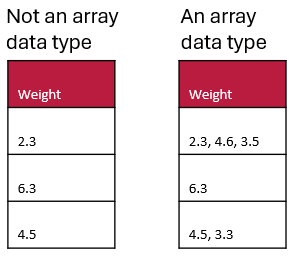
Array Datatypes for attributes
In Overlays Capture Architecture (OCA), when using the Semantic Engine you must assign data types to all of your attributes (aka variables). When do you use the array datatype?
You use an array data type when a data record for that attribute would hold multiple values of a specific data type, arranged in a list-like structure. Multiple values is the key. If you perform a measurement, and you record that single value in your data set, that attribute datatype is not an array of values; it is a single value.
However, if you collect multiple measurements, arrange them into a list using a separator to separate each value, and store that list of values in your dataset in a single record for a single attribute (e.g. in a single Excel cell where each value is separated by a comma), then you have an array.
Array data type example
Here are two examples. The table on the left does not have an array data type (it is datatype=numeric) whereas the table on the right contains an array data type (specifically array[numeric]) and uses a comma separator.

Array data types may be especially useful in questionnaires when you can allow multiple selections for a question (e.g. asking the user to select all the options that apply).
Here are the key characteristics and examples of when you would categorize a data type as an array data type:
- Multiple Elements: An array can store multiple values.
- Same Data Type: All elements in an array must be of the same data type (e.g., all numeric, all strings).
- Indexed Access: Elements in an array can be accessed via their index positions.
In summary, you categorize a data type as an array when it is explicitly defined to contain a collection of elements of the same type, accessible via indices, and useful for storing lists, collections, or sequences of values.
Written by Carly Huitema



